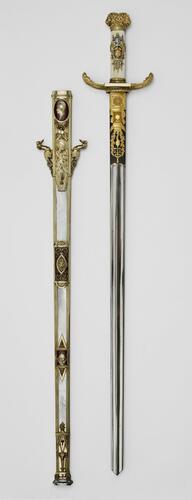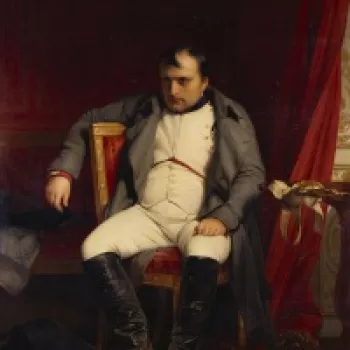Robe sword and scabbard 1802-03
Sword: silver-gilt, enamel, ivory, gold, steel. Scabbard: wood, mother-of-pearl, silver gilt | Length overall: 89.4 cm; length of blade: 74.5 cm; width 3.2 cm (whole object) | RCIN 61171
-
The silver-gilt hilt consists of a pommel made of two lions’ heads, back to back, one looking forward, the other to the rear, and a pair of quillons, arising from a rectangular quillon-block, flattened at right angles to the plane of the blade, with their rounded ends curving gently towards the pommel. The edges of the quillons are decorated with serpents, their necks entwined. The surface towards the hand is overlaid with a thin translucent panel of brilliant red composition resembling enamel, over which is applied, on each end, the head of a bearded man backed with acanthus foliage, and, on each side of the grip, an eagle, all in low relief. The surface towards the blade bears two hand looking-glasses in relief inscribed, on the one, 'Boutet/ Directeur/ artiste, and on the other, Manuf/ A/ Versailles'. In front of the quillons is a water-guard to fit over the mouth of the scabbard, decorated in low relief with egg and dart, each egg charged with a palmette. The very slightly barrel-shaped, longitudinally-reeded, ivory grip, which is of oval section, is set on each face with a silver-gilt panel in the form of a military trophy, including in the middle a Roman standard bearing the letters 'R.P.F', in gold in reserve against a pale blue composition ground. In the centre is a shield with a deep red compositon ground charged with the head of Mercury in gold in low relief. The silver-gilt ferrule towards the blade includes a torus moulding cast and chiselled with a wreath of oak leaves. The straight, double-edged blade, which is of flattened-lenticular section at the hilt, has two adjacent fullers of medium width flanking the central line, starting from the hilt and running right to the obtuse tip, which has convex edges. A panel at the hilt is overlaid with gold and engraved and punched on one face with a Roman scutum and two arrows in saltire, in a sunburst, and on the other with a cobweb-like devise, each in a frame, respectively edged with acanthus tips and laurel wreath. Beyond is a blackened and matted panel engraved and richly gilt on one face with a ship in full sail, viewed from her bows, supported by two hands whose wrists entwined by laurel branches, all on a plinth on which hangs a medal charged with a flaming heart, and all between a sword, owl and book on the dexter side, and a sword, flambeau and globe on the sinister side. On the other face are a laurel wreath, a balance, and a hand mirror with a serpent entwined about its handle, all supported by an upright spear arising from a flaming, winged tub, all between oak branches and set upon a pedestal ensigned with a triangle whose apex rests on a disk, and all between two arrows and a celestial globe on the dexter side and two cornucopiae on the sinister side. The scabbard has a wooden lining overlaid with plaques of mother-of-pearl, all framed in silver gilt, and four silver-gilt mounts. The locket is decorated in low relief on each side with a trophy of the Liberal Arts pendent from an oval cartouche framing a profile classical head viewed from his left, against a red composition ground on the one side, Liberty wearing a Phrygian cap and, on the other, Science with a diadem of stars. Beneath each of these cartouches hangs a swag of fruit and leaves. On each side of the locket projects a grotesque winged beast, in full relief, holding in its mouth a loose-ring for the baldrick. The chape is decorated with a tripod altar with clawed feet resting on an iron plinth consisting of a rectangular moulding, flanked towards the blade by a caveto moulding and, on the other side, by a shallow step which forms the end of the scabbard. The two other mounts take the form of broad bands with aprons above and below. The upper one is decorated on each face with a lion’s mask within a mandorla-shaped frame surrounded with scrolls of attenuated acanthus foliage, all applied against a red composition ground. Its aprons are half circles framing half a stylized flower. The lower one is similarly decorated with a globe in its stand. Its aprons are triangular, each framing an upright flowering plant.
Provenance
The sword was made by a workshop under the direction of Nicolas Noël Boutet which had been set up within the Manufacture de Versailles in 1793. Boutet was the son of Noël Boutet, 'Arquebusier des chevaux-legers du Roi'. He followed his father's profession and married the daughter of Pierre Desaintes, the 'Arquebusier Ordinaire du Roi'. Desaintes passed on his royal appointment to his son-in-law who subsequently worked for Louis XVI at Versailles and, after the Revolution, was employed by Napoleon Bonaparte as general manager of the Manufacture de Versailles in 1798 where weapons of the highest quality were produced. When he left Versailles in 1818 he traded from premises at 87 Rue de Richelieu in Paris but continued to use the signature 'Boutet à Versailles'.
The tip found on robe swords such as this was probably copied from the bronze blade of a Halstatt sword of Mindelheim type; in the late eighteenth and early nineteenth century such swords were thought to be Roman.
Bonaparte became First Consul in 1799 and Emperor in 1804 and it has long been thought that swords were made for each of the three Consuls but the survival of at least four examples suggests that one or more were made after the two new Consuls were appointed in December 1799, or that a spare was kept in reserve. A second very similar sword at Malmaison is that bequeathed by the Emperor to his son, the King of Rome, a third is in the Victoria & Albert Museum and a fourth, differing only in the coiffure of the head on the top locket, was lent to the Exposition Napoléon at the Grand Palais, Paris, in 1969.
A certificate accompanies the sword 'Je Sousigné Certifie qu’ayant été emplyé (sic) autrefois comme Emballeur De la Maison de S. M. L’Empereur Napoléon, il ma été affirmé par de personne que laproche que le glaive que J’ai Vandu a Messieurs Rundell Bridge et Rundell de Londres, lui avoit appartenu etant premier Consul – Cest pourquoi J’ai delivre le présent a Paris le deux Fevrier Milhuit cent Vingt Sept Chenne Layetier Emballeur du Garde meuble de la Couronne et du Musée rue croix des petets (sic) Champs No28’.
['I the undersigned certify that I was employed at one time as a 'Packer' in the house of SM Emperor Napoleon. It was affirmed to me by a person very close to him that the sword which I sold to Messrs Rundell & Bridge in London belonged to him when he was First Consul. That is why I delivered it to Paris on 2nd Feb 1827. Chenne. Layetier and 'Packer' to the Garde Meuble… etc'.]
The sword entered the Carlton House Armoury on 9 April 1827. -
Creator(s)
(place of production)(designer/maker)(nationality)Acquirer(s)
-
Medium and techniques
Sword: silver-gilt, enamel, ivory, gold, steel. Scabbard: wood, mother-of-pearl, silver gilt
Measurements
Length overall: 89.4 cm; length of blade: 74.5 cm; width 3.2 cm (whole object)
Category
Other number(s)
Place of Production
Versailles [France]











